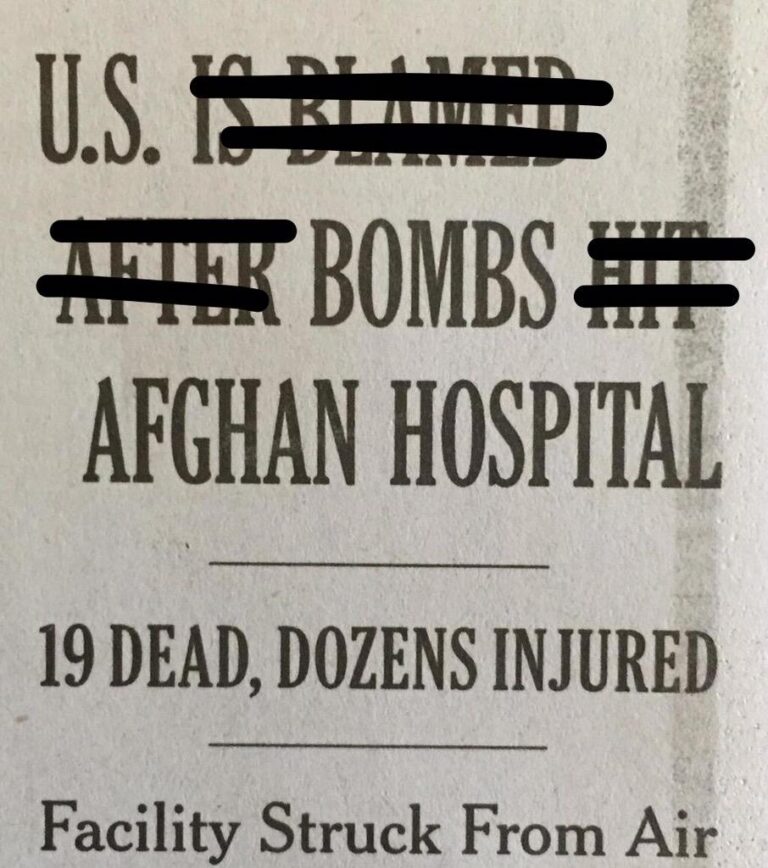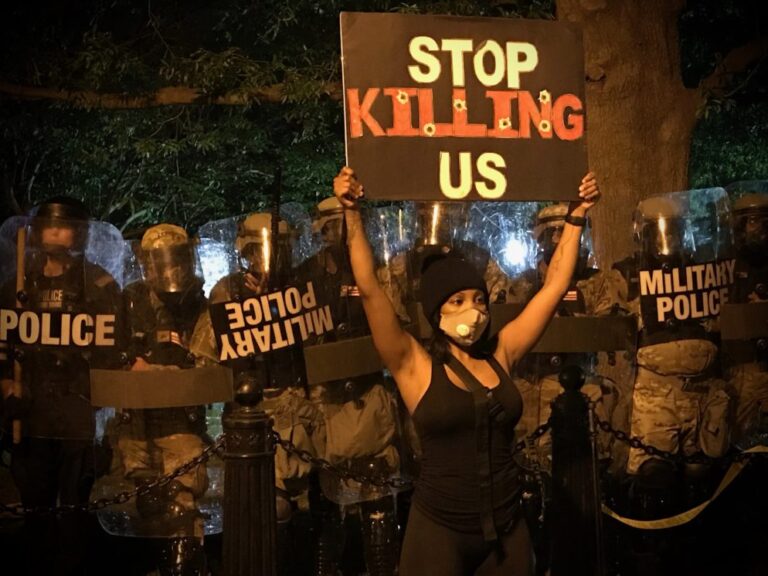Just out! Article by WRL Organizers Ali Issa & Tara Tabassi
No SWAT Zone:
Resisting Police Militarization Under Trump
A volunteer screams in pain as Hollywood-grade prosthetics litter a football field strewn with body parts and gore. A “Muslim man” just fired from his job returns to his office as a figure hooded in black, takes an ex co-worker hostage, and yells he wants “to hurt the Jews for what they have done to him and his people”; a bucket bubbles over with smoking “chemical weapon” liquid at his feet; a banner proclaims, “We are the 99%” and “No War for Oil” with protesters lurking behind it.
These three meticulously scripted scenarios are typical of the “training exercises” demonstrated at conventions for SWAT teams—or Special Weapons and Tactics (previously known as Special Weapons Attack Teams). They are often accompanied by vendors selling the latest in high-tech military weapons, gadgets, and gear. Colt Guns, Boeing, and Combined Systems, Inc. (CSI) are frequent sponsors. These are accompanied by “shwag”: pins that urge to “face-shoot the mother fucker,” t-shirts that read “Black Rifles Matter” or “Keep Calm and Return Fire” printed beneath an American flag, and free bracelets featuring a black and white American flag with the “thin blue line,” symbols long associated with a “War on Cops” and the “Blue Lives Matter” slogan. Attendees, hailing primarily from police departments, are given a jam-packed weekend agenda, from workshops on the Israeli Defense Force’s Krav Maga martial arts to presentations on the continuing growth of “Jihad in America.”
These SWAT trainings and police militarization conventions happen 365 days a year all over the world. In the United States, where the arms industry has become increasingly intimate with law enforcement and emergency response agencies, the federal government foots much of the bill.
Given the frequency and high drama of SWAT trainings, one would think that people in the U.S. live under a constant military threat. But an analysis of SWAT raid logs shows that police militarization is most commonly used for conventional criminal operations, drug busts, searching houses, and serving warrants. Contrary to the narrative that SWAT teams conduct specialized policing, they are usually called on for mundane, everyday crimes, and act using the hypermilitarized and aggressive skills with which they were trained. The murder of Aiyana Jones, a 7-year-old Black girl who was shot in a Detroit no-knock SWAT raid in 2010 after a flash grenade was thrown through the front window, made abundantly clear how war mentalities are enacted through SWAT killings.
How did we end up on this course of heightened police militarization? And, more importantly, how can we stop it?
What Are SWAT Trainings?
In 1967, LAPD Inspector Daryl Gates came up with the concept of SWAT based on his experience policing Black uprisings such as the Watts Riots. The War on Drugs saw higher rates of lethal force as the government transferred military equipment to police departments—a transfer that was motivated out of the government’s fear of Black liberation and antiwar movements. Post-9/11, the U.S. Patriot Act’s expanded law enforcement surveillance and the subsequent federal funding of military equipment and tactics for local police departments. The Pentagon’s military weapons transfer program to police departments—known as the 1033 Program—has distributed more than $5 billion dollars in equipment since 1990.
SWAT trainings are often a major driver of the escalated police militarization we see in neighborhoods of color and protests across the country. Their increase is not subtle: While SWAT raids were estimated at eight per day in 1980, there are now approximately 137 SWAT raids a day that are used for everyday search warrants. This increase is driven by the growing prevalence of “SWAT trainings.”
What happens at SWAT trainings is a chilling vision of the kind of policing the Trump administration is expanding and intensifying. Occurring year-round, though often concentrated in the fall in the U.S., these events bring together local, state, regional, and federal law enforcement personnel, weapons industry vendors of all types (from the sellers of Tasers to tanks), and most ominously first-responders and emergency medical technicians/fire-department.
Always present at the expos are weapons giants, common war profiteer culprits such as Safariland, Combined Systems (CSI), Northrop Grumman, BAE Systems—all of which maintain major contracts with the U.S. and many militaries worldwide. Civilian companies such as Uber, CamelBak and Verizon sell specialized tactical items, or sponsor through advertisements. Conferences range from local events to crown-jewel gatherings like Urban Shield, called by many the largest SWAT training in the world. Urban Shield annually brings hundreds of participants from every region of the country, and many global actors such as Israeli, Brazilian, and Norwegian police.
In addition to sites where law enforcement agencies plan their coming year’s shopping for new toys, they often host Hollywood-style “exercises” which simulate attacks or disasters to which participants “respond,” competing for top SWAT honors.
This brings us to one of the major ideological functions of these events: defining “the enemy.” It is no coincidence that notorious Islamophobic demagogues like Ryan Mauro and Sebastian Gorka have been keynote speakers at these events, since their (never validated) “expertise” on Islam and terrorism serves to generate fear of impending attacks in the U.S. and feeds directly into the ISIS and Al-Qaeda think-tank industries. The SWAT trainings also define who counts as an “insider,” by offering attendees the opportunity to network raffles, BBQs and pig-roasts (no pun intended).
Militarized mentalities rely heavily on cultures of fear, white supremacy, heteropatriarchy, and warfare logic of “us vs. them,” while successfully permeating through agencies, such as police departments, normalizing violence against those already deemed disposable, dangerous and/or “radical,” and dramatically amplifying the force of militarism through our communities.
Over the last year we have deeply researched 6 SWAT trainings/weapons expos across U.S. regions (Southern California, the Bay Area, the Midwest, and Upstate NY, among others), seeding cross-community campaigns to resist them, as inspired by solidarity work with movements facing tear gas in Egypt, Chile, and beyond. This work has offered many takeaways we find valuable for organizing.

1. It’s Not Just the Weapons, Y’all. It’s the Militarized Mentality Behind Them.
When campaigning against SWAT trainings, it is easy to get caught up in what arms dealers are selling at expos, and what the use-of-force industry is creating specifically for police. But it’s also equally crucial to look behind the weaponry and to address the militarized mentality and culture underlying it. It is only by exposing the ways that law enforcement officers are intentionally trained that we can begin to unpack the militarized mentalities of aggressive beat-cops and resist the aspects of militarism that affect people in everyday ways.
These weapons expos are regularly paired with workshops facilitated by arms dealers that market masculinity, defense industry solutions, and militarized mentalities. Workshops advocate for limited solutions to complex problems; for example, as the National Tactical Officers Association (NTOA) has done with a workshop entitled, “Talk-Fight-Shoot-Leave,” encouraging use-of-force solutions and “warrior mentalities” over de-escalation tactics. Use-of-force is often sold as a solution for scenarios involving mental health crises. (We’ve campaigned against conferences where SWAT officers are advertised as better equipped than medical professionals to deal with such crises).
It is thus not a surprise that SWAT teams, the foot soldiers of the notoriously racist “war on drugs” have historically brought a war-making mentality to the daily practice of policing and arrest.
2. Fear of “Muslim Terror” Justifies Black + Latinx Death
The threat of domestic Islamic terrorism is a regular justification for SWAT trainings, which is why they feature Fox News blowhards to claim that pockets of the U.S. are controlled by Islamist militias, or that the Council on American Islamic Relations (CAIR) is an imminent threat. These gatherings are veritable Islamophobia factories: resisting them means fighting that type of hate and reminding people that actual domestic terror attacks are extremely rare.
But even while they peddle Islamophobia in theory, SWAT tactics are not primarily used against non-Black American Muslims in practice. Rather, hundreds of SWAT raids a day overwhelmingly target poor and working class Black and Latinx communities across the country. Islam is used a smoke screen to strengthen and enact a different kind of racism on the ground. This is notwithstanding the often forgotten fact that an estimated 25 percent of U.S.-born Muslims are African American.
This reality provides fertile ground for non-Black Muslims in the U.S. to work in accountable coalitions with Black and Latinx communities. The SWAT raids killing and traumatizing those communities are also promoting a paranoid political culture that legitimizes wars abroad. By targeting both police and militarization together, it’s possible to challenge racist police brutality, surveillance of Muslim American communities, and the global “war on terror” all at once.
3. Reaching Beyond the Choir
Seeding coalitions across the country has provided an important, concrete way for groups to collaborate across a wide variety of identities and ideologies—a move for anti-sectarianism that is needed now more than ever. However, it is also where our work has often failed in its reach beyond the activist class. With the desire to lift up frontline communities, we frequently find ourselves closest to and most able to uplift young QTPoC voices that are often college educated, middle class and/or paid organizers and activists such as ourselves, who are able to have meetings and rallies during working hours. How do we break out of this habit and shift our organizing strategies so that we can truly scale up our work in the ways that are urgently needed to shift power in the face of a neo-fascist regime?
We take inspiration from convergences that maintain community leadership and principles, reaching broad bases and mainstream minds, while pushing for visionary goals, such as the frontline work seeded by Indigenous-led #noDAPL convergence at Standing Rock or the consciousness shifting work that multiple Black Lives Matter groups have been achieving across the country for the past year plus. As this case study from North Carolina urges us, we must reach beyond the choir—now more than ever.
4. Ending Militarism Everywhere
SWAT trainings are the ugly tip of an even uglier iceberg. Militarism generally is permeating more deeply into social life. Despite the rhetoric that the Department of Homeland Security keeps communities “safe,” federal funding for police and law enforcement often harms those very same vulnerable communities—most obviously through purchasing drones, but also through insidious policies or regular police institution maintenance (such as paying officer over-time). Police militarization funding that promotes policing practices such as Broken Windows or “community policing” does not keep any community safe, especially already criminalized peoples.
We need new visions of safety that do not rely on counter-terrorism monies from the Department of Homeland Security or extreme policies of mass deportation, border securitization, increased vetting, travel bans, and border walls. We need real sanctuary spaces that provide refuge from the increased federal raids. We need to lift up groups leading the way in both shifting the culture, while also providing immediate support, like DRUM is doing by building local No Hate Zones across NYC neighborhoods, or Mijente by driving national sanctuary expansion, or Not1More by taking direct and strategic action against deportations across the country. We applaud all cities and towns that have joined the Sanctuary Cities movement (whether legally or symbolically). We call on more cities to become Sanctuary Cities, so that we may reclaim safety, and defend our cities’ and world’s most vulnerable. It is essential to bring the question of militarism into organizing on every issue. Right now, the connections have never been more insidious.
Engaging with militarism where we can recognize it first—in U.S. police, prisons, and borders—allows for the sparks of an internationalist connection to appear. Pushing for the U.S. public sector to demilitarize its institutions, question the increasing hybridity of policing and militarism, and rejecting Department of Homeland Security funding locally will hopefully orient domestic activists to better question international militarism more broadly, starting with the U.S. military’s budget of $1.3 trillion (more than all global militaries combined). Perhaps then we can share a positive vision for a new internationalism—a global movement that leaves no one behind, and which prioritizes aligned solidarity campaigns over empty metaphors. One where “Not Here, Not Anywhere,” as a Stop ITOA banner in Chicago read, can begin to be realized.
5. War At Home?
We have been fighting SWAT trainings because they result in direct harm to some of the most vulnerable communities in the United States. SWAT raids show how there is a “war at home” for Black, Latinx, poor, Muslim, and Arab communities domestically. In reality though, “the war” is in no way here, and remains fundamentally different from wars happening in Afghanistan, Syria, Iraq, Democratic Republic of Congo, Yemen, Colombia, Somalia, and many other parts of the world. We raise this not to engage in Oppression Olympics, but to point to the scales of violence that are sometimes conflated in the service of mobilizing metaphors that will ultimately not lead us to the global solidarity and anti-militarist movement that this world, and especially this country, really needs.
Identifying and lifting up similarities between lived realities can be a starting point for building solidarity, but if and when ended there, it can become harmful to building meaningful relationships and providing material support that is conscious of how state violence and global violence differ across contexts. We call for building deeper connections between communities, and are wary of forgetting that U.S. exceptionalism is in effect even within our progressive organizing spaces. How can we create narratives and campaigning realities that assert internationalism in all aspects of our work? We call for organizing against Islamophobia globally—not just protecting the dignity of fellow Muslim-Americans, but instead all Muslims around the world being impacted by war and militarism. We call for organizing that asserts Black Lives Matter across the world, not just that Black American Lives Matter.
Most importantly, what is lost in this dynamic is that when you actually speak with them, Iraqis, Afghans, and Colombians often tell us that they do not want pity. Rather, people living amid conflict often want to be recognized first as human, and then, at times, as partners in struggle who have much to teach us in the global North about organizing in warzones, or under authoritarian regimes. As the Right gains strength all over the West, lessons from the feminists in Iraq that are building women’s shelters underground in Baghdad, for instance, are crucial for us now as we scour for hope.
Onward!
We hope these five starting points help organizers around the country shape campaigns, projects, and discussions aimed at dismantling police militarization locally, in the hope of denting militarism globally. Those near the Bay Area should hit up Stop Urban Shield coalition; those around Chicago, Stop ITOA Coalition; and those on the East Coast, or anywhere, hoping to learn more about resisting police militarization, contact War Resisters League.
Police militarization will expand under Trump with his promises for increasing already inflated public safety and border patrol budgets and agents. While we’ve been campaigning against SWAT trainings and weapons expos for years, the present political terrain almost certainly will offer no federal concessions (such as our long-standing demand for the Senate to cut UASI’s budget).
We will need to be in the streets, enacting creative nonviolent resistance, calling for policy reform and legislative shifts—but we also need to be embodying collectivism, willingness to work together, and a disengagement of policing and use-of-force culture: institutionally, with each other, and around the world.
Share




